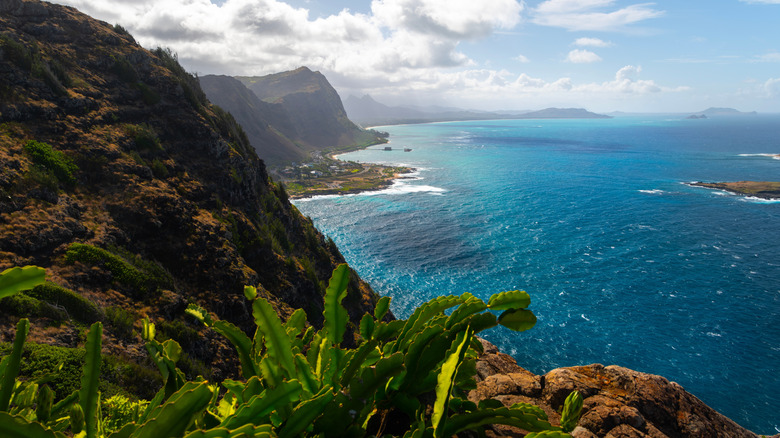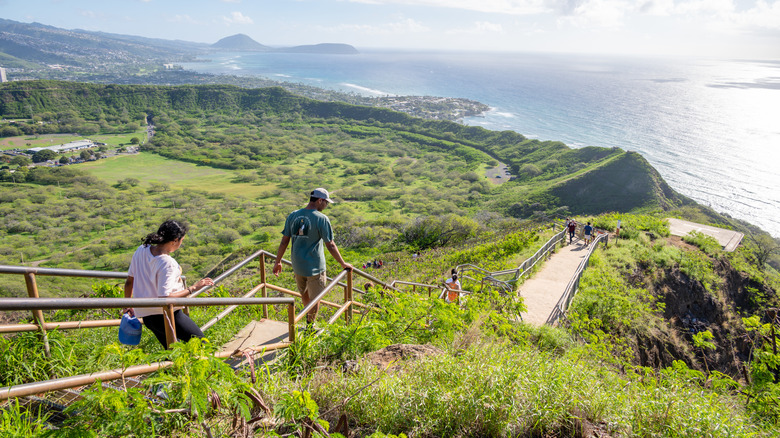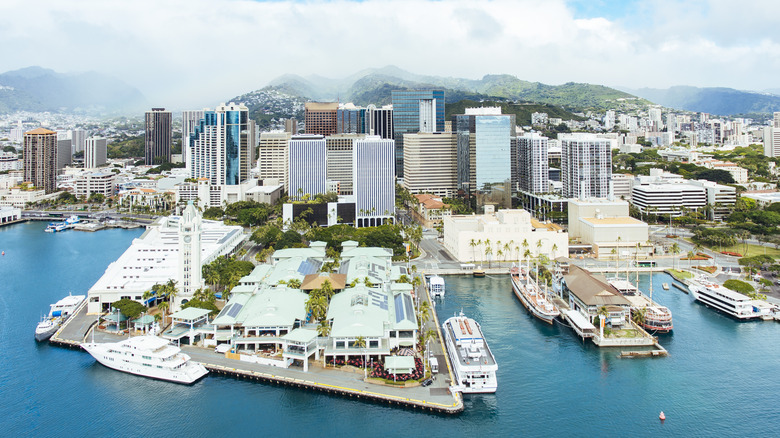This Wildly Popular Hawaiian Tourist Destination Is Sinking Into The Pacific Ocean At An Alarming Rate
The climate crisis is affecting populations all across the planet, but some Pacific islands are feeling the effects faster than others. This includes the state of Hawaii — and the island of Oahu, in particular. A new study by researchers at the University of Hawai'i at Manoa has found that Oahu is sinking 40 times faster than other parts of the island chain.
According to the study, parts of Hawaii could be in danger of serious flooding, both from the coasts and rising groundwater inland. While some of the blame can be attributed to geography and rising oceans, overdevelopment has hastened the rate of sinking or subsidence, the study explains. "Much of the urban development and infrastructure, including parts of the industrial Mapunapuna area, is built on sediments and artificial fill," said Kyle Murray, one of the lead authors of the study, in a news release. "We think the majority of subsidence is related to the compaction of these materials over time."
Oahu isn't the only tourist destination with this problem. Accelerated by climate change, the Italian city of Venice has been sinking for decades, leaving many visitors to wonder if they should visit. Knowing more about what's happening at your destination is key to any travel plans.
Oahu is sinking under the weight of volcanoes and urban sprawl
Hawaii's awe-inspiring volcanoes are not only one of the state's main attractions, they are the reason the islands exist at all. Hawaii was formed — and is still being shaped by — a series of volcanic eruptions within the Pacific tectonic plate. New land is formed when the tectonic plate slides over a plume of molten rock from beneath the earth's surface, creating a so-called hotspot underneath Hawaii's Big Island. When the molten rock cools, it solidifies, forming islands. The further an island is from the hotspot, the more it settles, sinking beneath the surface of the ocean. This is a natural process of subsidence that has been happening for millions of years in Hawaii.
The recent study shows, however, that man-made causes are accelerating the rate of subsidence, particularly on Oahu, where Hawaii's natural beauty blends with urban infrastructure. Oahu is Hawaii's third-largest island and also the most heavily populated, with just under a million people, or nearly two-thirds the population of the state. It's home to the state capital of Honolulu and the US military command center for the Pacific. In addition, roughly 9 million tourists a year come to Hawaii, most flying through Honolulu airport in Oahu.
That puts a lot of weight and pressure on Oahu's foundations. In particular, the Mapunapuna industrial area near Honolulu airport is a low-lying area that's farther inland, but built on reclaimed land. The University of Hawai'i at Manoa study found, as reported in Nature magazine, that flood exposure in that region could rise by more than 50% in less than 25 years.
Rising waters from the sea and underground in Oahu
The heavier the infrastructure in these low-lying areas, the higher the risk of sinking under rising waters — and not just from the coast, explained University of Hawai'i coastal geologist Shellie Habel in Knowable Magazine. Residents in Honolulu, she points out, were shocked to find flooding almost a mile from the coast in 2017. "The ocean is in direct contact with coastal groundwater," she wrote in the magazine. "If you've ever built a sandcastle on the beach, digging a moat that fills with water from below, you've experienced this firsthand. As sea level rises, coastal groundwater levels rise too."
For visitors, that means being aware of the risks at your destination. Hawaii is prone to flash floods, particularly during the rainy season between October and April. Before arriving, visitors should familiarize themselves with emergency services and procedures in their area. During the wet season especially, check the forecast and avoid low-lying flood-prone areas.
Oahu remains one of the best and most accessible places to experience Hawaii. The state is working to prevent flooding by channeling water away from populated areas. Hawaii's Office of Public Health and Preparedness has also published guidance on how to respond to flooding. Hawaii can be a magical experience. To travel safely and responsibly, keep up to date with the latest advice on weather warnings and emergency procedures.


